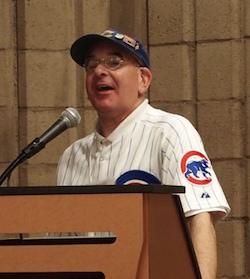Argument preview: Searching for an accrual rule when the government fabricates evidence in a criminal proceeding

on Apr 10, 2019 at 4:02 pm

McDonough v. Smith, to be argued on April 17, offers the Supreme Court another opportunity to clarify when civil-rights claims accrue, when statutes of limitations begin running, and how to define the interaction between civil and criminal litigation for resolving constitutional claims. The claim here alleges fabrication of evidence in a criminal proceeding.
Petitioner Edward McDonough was the Democratic Commissioner of the Rensselaer County (New York) Board of Elections. A 2009 investigation revealed fraud in a primary election. The county district attorney was disqualified from the investigation, so the state court appointed respondent Youel Smith as special prosecutor to investigate and prosecute the matter. Smith’s investigation targeted McDonough, allegedly through fabricated evidence, fabricated affidavits, false testimony and faulty DNA analysis. A grand jury indicted McDonough on multiple felonies based on Smith’s presentation of this evidence. A first trial ended in a mistrial, while a second ended in McDonough’s acquittal on December 21, 2012; Smith prosecuted both cases using the allegedly fabricated evidence.
On December 18, 2015, McDonough filed an action in federal district court under 42 U.S.C. § 1983, alleging malicious prosecution and fabrication of evidence before the grand jury and at the two trials, in violation of the Fourth, Fifth, Sixth and 14th Amendments. The statute of limitations on Section 1983 claims in New York is three years. The district court dismissed the fabrication-of-evidence claim as untimely and the U.S. Court of Appeals for the 2nd Circuit affirmed. Although McDonough sued within three years of his acquittal, the 2nd Circuit held that the statute of limitations on a fabricated-evidence claim begins to run when the federal plaintiff becomes aware of the improper use of fabricated evidence and has been deprived of liberty in some way. That occurred during McDonough’s first trial, more than three years before he filed his civil action. The court acknowledged that its approach departed from that taken by the U.S. Courts of Appeals for the 3rd, 9th and 10th Circuits, all of which hold that a fabrication claim accrues only after criminal proceedings have terminated. The 2nd Circuit affirmed dismissal of the malicious-prosecution claim on grounds of absolute prosecutorial immunity.
Arguments of petitioner McDonough
The crux of McDonough’s argument is that the limitations period began to run upon his acquittal on December 21, 2012, making his December 18, 2015 lawsuit, filed less than three years later, timely. He offers three avenues to that conclusion.
McDonough’s first and preferred approach analogizes a fabrication-of-evidence claim to the tort of malicious prosecution. McDonough claims that his constitutional rights were violated by Smith’s initiating and maintaining criminal proceedings against him on the basis of fabricated evidence — like malicious prosecution, this claim is based on the wrongfulness of the prosecution. While some fabrication claims might be analogous to other torts — for example, a claim seeking damages for evidence fabricated before legal proceedings begin looks more like the tort of false arrest — McDonough seeks damages for the violation of his rights after the criminal process began.
Because this claim looks like malicious prosecution, it should be subject to that tort’s special rule that the clock does not begin running until the criminal proceedings are resolved in favor of the criminal defendant/civil plaintiff. That distinctive rule regulates the relationship between criminal and civil proceedings, discouraging parallel litigation by allowing an individual to defend himself in the criminal proceeding, then challenge the fabricated evidence through civil litigation upon favorable termination of that proceeding. Under that rule, McDonough’s filing was timely. McDonough argues that the Supreme Court can borrow this special limitations rule without needing to identify the elements of a fabrication-of-evidence claim.
A second approach is to apply the standard accrual rule but to adopt favorable termination as an element of a Section 1983 fabrication-of-evidence claim. Under the standard rule, the limitations period begins to run when the plaintiff has a complete and present cause of action and can sue and obtain relief; that requires the plaintiff to be able to satisfy all elements of the claim. If favorable termination is an element of the Section 1983 claim, as it is for the analogous malicious-prosecution tort, this element was not satisfied until McDonough’s acquittal, less than three years before his claim was filed.
This approach is consistent with Supreme Court precedent in Preiser v. Rodriguez and Heck v. Humphrey. Those cases together establish that an individual cannot use Section 1983 to undo or reduce a conviction or sentence or to challenge the validity of a conviction or sentence. A person in state custody wishing to challenge custody must pursue relief through a petition for writ of habeas corpus and someone seeking damages arising from his conviction or sentence must show favorable resolution of the criminal proceedings. Making favorable termination an element of a Section 1983 fabrication-of-evidence claim furthers the goals of Preiser and Heck — avoiding parallel litigation and focusing challenges to the fact or duration of conviction in state criminal proceedings and not federal Section 1983 litigation. McDonough argues that the court can adopt the favorable-termination element regardless of whether the fabrication claim is grounded in the Fourth, Sixth or 14th Amendments, because the reasons for delaying the start of the limitations period are the same — to allow state criminal proceedings to move to their conclusion without federal interference.
Under a third approach, McDonough suffered a “continuing violation” of his constitutional rights, rather than an injury from a “discrete act.” The limitations period thus did not begin to run until the continuing violation ended, when the acquittal ended the criminal proceedings. Smith’s fabrications led to criminal charges and two criminal trials against McDonough; he suffered an ongoing violation as long as those proceedings, grounded on fabricated evidence, continued. McDonough argues that this case offers a strong example of a continuing violation, because Smith allegedly fabricated multiple pieces of evidence and witness testimony and used that fabricated evidence at various points throughout the criminal proceedings.
Arguments of the United States as amicus curiae
The United States appears as amicus curiae supporting reversal of the 2nd Circuit. It urges the Supreme Court to adopt the second of McDonough’s proffered approaches. A plaintiff must show, as an element of a Section 1983 fabrication-of-evidence claim, that the criminal proceedings terminated in his favor, just as he must for an analogous malicious-prosecution tort. The United States agrees with McDonough that under that rule, the claim was timely.
The United States offers several reasons for a favorable-termination element. That element ensures that federal civil-rights litigation will not interfere with state criminal proceedings, promoting consistency and respect for the judicial process and federal-state comity. It provides evidentiary benefits, because favorable termination suggests that the fabricated evidence was material to the decision to charge the individual improperly. And the rule is easy to apply, providing parties and courts with a single clear point at which the violation is complete and a claim can be brought.
The United States does address some issues that McDonough urges the court to avoid. Although agreeing that the court need not determine the source of the constitutional right to be free from proceedings that use fabricated evidence, the United States argues that the claim “most naturally” sounds in due process. Just as knowing use of fabricated evidence to obtain a conviction violates due process, knowing use can violate due process without a conviction if the individual was deprived of liberty at some point. In contrast, the Fourth Amendment governs unreasonable searches and seizures rather than unreasonable prosecutions, and the Sixth Amendment’s guarantee of a right to a speedy and public trial by an impartial jury does not assume anything about the evidence used in that trial.
Finally, the United States argues that the district court on remand should “likely” dismiss the fabrication-of-evidence claim on grounds of absolute prosecutorial immunity. A prosecutor is absolutely immune for all conduct undertaken in the role of advocate for the state in the judicial portion of the criminal process, including initiating and pursuing charges and offering evidence before a grand jury and at trial. A prosecutor is not absolutely immune for conduct undertaken in the role of investigator. In this case, the prosecutor allegedly used fabricated evidence not in his investigative capacity, but in his capacity as an advocate. “In short, petitioner is correct that his claim for fabrication of evidence is analogous to one for malicious prosecution, but the analogy drives home that petitioner’s fabrication claim is likely barred by prosecutorial immunity.”
Arguments of respondent Smith
Smith begins from the premise that the Supreme Court must identify a specific constitutional right, not rely on common-law analogies, as McDonough and the United States suggest. Under either approach, Smith argues, McDonough has not stated a timely claim.
Smith first accepts the framing of the case offered by McDonough and the government. Smith argues that McDonough asserted two claims — malicious prosecution and fabrication of evidence. The 2nd Circuit affirmed dismissal of the former on grounds of prosecutorial immunity. It follows that the fabrication-of-evidence claim must be distinct from the malicious-prosecution claim, specifically by not requiring favorable termination and by presenting a viable claim even if there was probable cause to proceed with the prosecution. A fabrication-of-evidence claim presumes that some government conduct is “so egregious that it should give rise to a constitutional claim even if that conduct had no effect on the outcome of the proceeding.” But when or how the criminal proceeding concluded is irrelevant to the validity of such a claim. The end date of the criminal proceedings therefore cannot serve as the accrual date. Instead, the claim accrues when the wrong — creating and using the fabricated evidence — occurs and when the plaintiff learns of the fabrication. In this case, that occurred more than three years before McDonough filed his civil action.
Alternatively, Smith argues that the Supreme Court must cast McDonough’s claims in terms of specific constitutional violations. The malicious-prosecution claim would be a Fourth Amendment claim challenging his indictment without probable cause and would be barred by prosecutorial immunity (as the 2nd Circuit held). The fabrication-of-evidence claim — challenging use of fabricated evidence regardless of the outcome of the criminal proceedings — must sound in substantive due process, involving executive misconduct sufficiently outrageous to “shock the conscience.” If there is such a constitutional right (a point Smith does not concede but that he says the court need not resolve), “it accrues when the allegedly outrageous act occurred” — when fabricated evidence was used before the grand jury and at trial. If the constitutional violation occurred independent of the outcome of the criminal proceeding, then the date of that outcome is irrelevant to the accrual of the claim or timeliness of the suit.
Smith rejects McDonough’s reliance on Heck and Preiser, which he argues do not apply to this case. Heck does not apply because McDonough never was convicted, meaning his Section 1983 claim cannot undermine an existing conviction or sentence. Preiser is irrelevant because McDonough was not in custody (a prerequisite to filing a habeas petition) and his fabrication claim did not challenge the validity of any custody.
Finally, Smith argues that the continuing-violation doctrine cannot save McDonough’s claim. A claim accrues when some injury occurs. McDonough was injured by the initial use of fabricated evidence, creating a complete and present cause of action and an accrued claim. That he suffered additional injuries during the course of the criminal proceedings does not mean the claim did not accrue when the first injury occurred. Moreover, under the continuing-violation theory, some unlawful act must take place within the limitations period. The unlawful acts in this case — using the fabricated evidence before the grand jury and at trial — occurred earlier than December 18, 2012 (three years before the civil action was filed).



